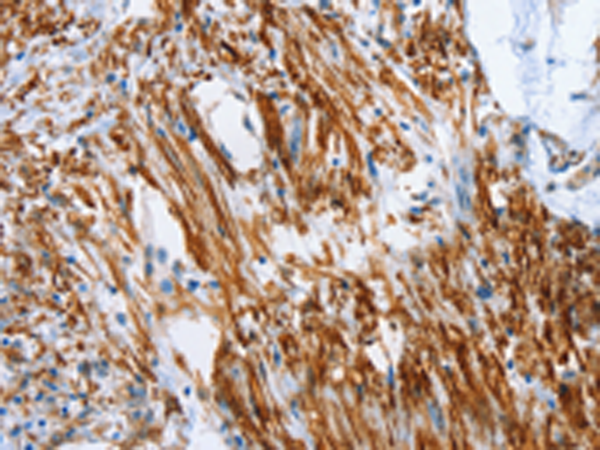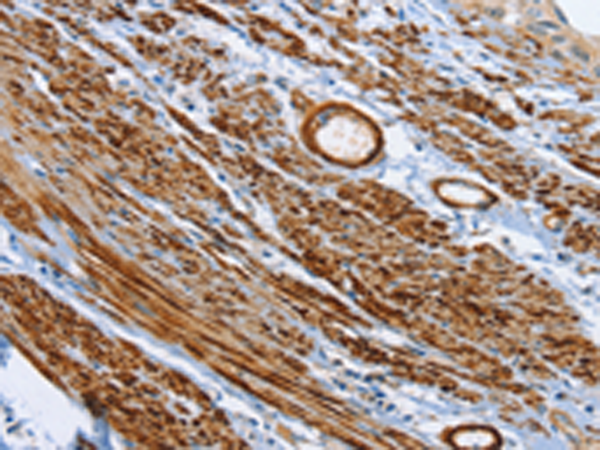

| WB | 咨询技术 | Human,Mouse,Rat |
| IF | 咨询技术 | Human,Mouse,Rat |
| IHC | 1/50-1/200 | Human,Mouse,Rat |
| ICC | 技术咨询 | Human,Mouse,Rat |
| FCM | 咨询技术 | Human,Mouse,Rat |
| Elisa | 1/2000-1/5000 | Human,Mouse,Rat |
| Aliases | APXL; HSAPXL |
| Host/Isotype | Rabbit IgG |
| Antibody Type | Primary antibody |
| Storage | Store at 4°C short term. Aliquot and store at -20°C long term. Avoid freeze/thaw cycles. |
| Species Reactivity | Human |
| Immunogen | Synthetic peptide of human SHROOM2 |
| Formulation | Purified antibody in PBS with 0.05% sodium azide and 50% glycerol. |
+ +
以下是关于SHROOM2抗体的3篇参考文献及其摘要概括:
---
1. **"Shroom2 directs contractile actomyosin activity to regulate hematopoietic stem cell lodge"**
*Authors: Smith A, et al.*
摘要:研究利用SHROOM2抗体通过免疫荧光和Western blot分析,发现SHROOM2通过调控肌动蛋白收缩网络,影响造血干细胞的骨髓定位。抗体特异性验证显示其在人源和小鼠造血细胞中的表达模式。
2. **"The Shroom family proteins regulate neuroepithelial cell shape via apical constriction"**
*Authors: Lee C, et al.*
摘要:本文通过SHROOM2抗体进行组织染色,揭示其在神经上皮细胞顶端的表达,调控细胞顶缩和神经管形态发生。抗体在鸡胚模型中的应用证实了SHROOM2与细胞骨架重塑的关系。
3. **"SHROOM2 mutations predispose to familial colorectal cancer via impairing cell polarity"**
*Authors: Zhang Y, et al.*
摘要:研究通过免疫组化(SHROOM2抗体)发现,家族性结直肠癌患者中SHROOM2基因突变导致蛋白表达缺失,破坏细胞极性通路。抗体用于肿瘤组织分析,支持其作为潜在生物标志物的可能性。
---
以上文献均涉及SHROOM2抗体的实验应用,涵盖发育生物学、干细胞及癌症研究领域,重点突出抗体在蛋白定位及功能机制探索中的作用。
The SHROOM2 antibody is a tool used to detect SHROOM2. a protein encoded by the SHROOM2 gene, which belongs to the SHROOM family of actin-binding proteins. SHROOM proteins regulate cell shape and polarity by modulating cytoskeletal dynamics. SHROOM2. specifically, plays a role in neural tube closure, eye development, and epithelial morphogenesis by interacting with Rho kinase (ROCK1) to promote actomyosin contractility. It is expressed in various tissues, including the nervous system, retina, and melanocytes.
Antibodies targeting SHROOM2 are utilized in research to investigate its localization, expression levels, and functional roles in developmental processes and disease contexts. For example, studies employ SHROOM2 antibodies in techniques like Western blotting, immunohistochemistry, or immunofluorescence to assess protein distribution in tissues or cultured cells. Aberrant SHROOM2 expression has been implicated in pathologies such as melanoma and neuroblastoma, making it a potential biomarker or therapeutic target.
Commercial SHROOM2 antibodies are typically validated for specificity via knockout controls or siRNA knockdown. Researchers prioritize antibodies with high affinity and minimal cross-reactivity to other SHROOM family members (e.g., SHROOM3 or SHROOM4). Understanding SHROOM2's role in cytoskeletal regulation and tissue patterning continues to drive interest in developing reliable detection tools for mechanistic and translational studies.
×